Astronomical Imaging - Planetary Nebula
I’d like to share some astronomical images I have made over recent years of some fascinating objects called planetary nebula. These images were acquired with a range of amateur level telescopes ranging from 6-14” from a location in the suburbs of Brisbane, Australia. Even without professional level telescopes and a remote mountaintop location it is surprising what can be seen or imaged. To start with here is an image of the Helix Nebula, which although one of the largest planetary nebula needs a very dark sky to be seen easily. A camera is really needed to show the object well however.
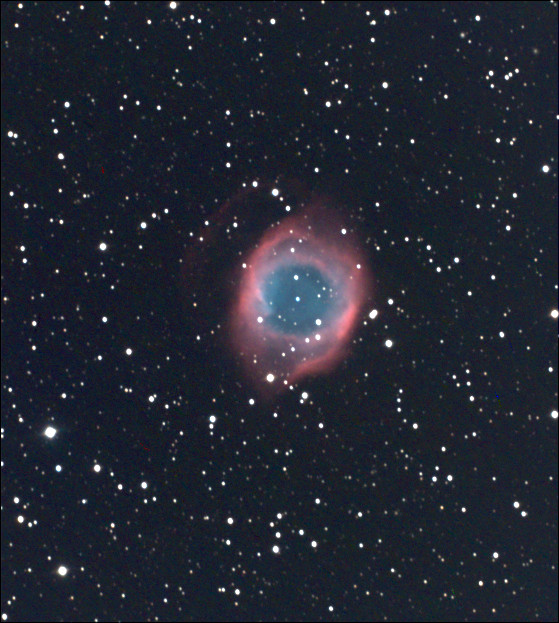
So, what causes planetary nebula like the Helix Nebula? In simplest terms, when stars similar in size to the sun their cores become extremely energetic and end up expelling the outer layers into space to form a large gaseous envelope. Now if the star is sufficiently hot and bright, the electrons in the surrounding gas can be excited to higher energy levels so that when the fall back to lower levels they emit light. This what we see as the planetary nebula.
IC418 - The "Spirograph Nebula"
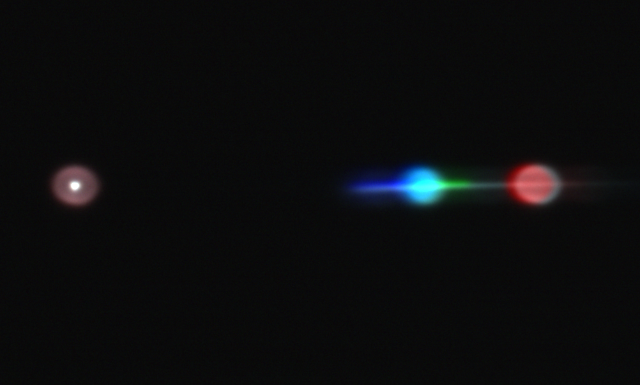
IC418 is about 1100 Lightyears distant and images with very large telescopes show a highly detailed filamentary structure very similar to a Spirograph drawing. With a smaller amateur telescope, it looks like a relatively featureless small round nebula surrounding a star. This image however, is not a conventional image of IC418 as a diffraction grating was inserted between the camera and telescope. This splits the light according to its wavelength, much like a prism, in a band at the right. Note that the central star forms an almost continuous band from the blue all the way to red part of the spectrum, but the planetary nebula itself shines in discrete points in the red and green portions of the spectrum.
The red color comes from the emission of a photons from Hydrogen, when an electron that has been excited to the 3rd quantum orbital level drops back to the 2nd quantum orbital level. The green color comes from doubly ionized oxygen, where 2 electrons have been stripped from an Oxygen atom and one of the remaining electrons bound to the Oxygen drops from an elevated quantum level to a lower level. Planetary nebulae are thought to be a major contributor to the elements that make up our own bodies (like Carbon and Oxygen).
NGC6302 - The "Bug or Butterfly nebula"
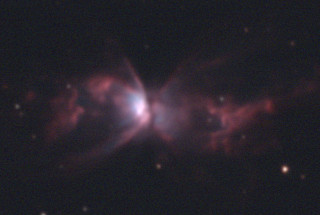
The planetary nebulas shown so far are generally spherical or shell like in appearance, but NGC6302 has a very different appearance. With the centre of the nebula is an extremely hot star believed to have a surface temperature of 250,000C, and around this star is a dense equatorial ring of dust. This dust ring appears to collimate the ejected material from the star so that it forms 2 lobes as shown here. In the image above the dust ring appears as a dark vertical lane near the brightest portion of the nebula, with the star likely hidden by the dust. This is a very large object that is some 3,400 light years away. If it were as close as the Helix nebula it would be easily visible to the naked eye.
NGC3242 - "Eye Nebula or Ghost of Jupiter"
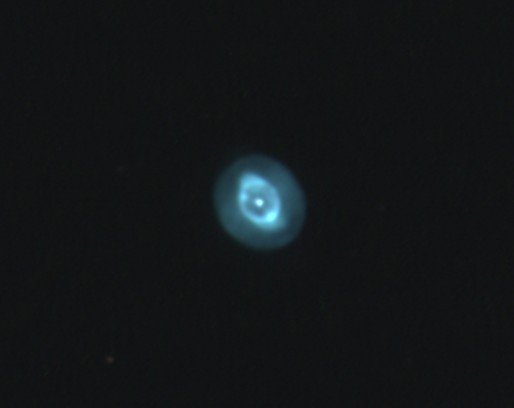
NGC3242 is one the brighter and more readily observed planetary nebula. The eye itself is visible in an ordinary telescope, without needing to resort to a sensitive camera. Not visible in the image above are FLIERs, which stands for Fast Low-Ionization Emission Region’s. These are small regions, typically reddish, that are travelling at high speed and punching through and out of the main nebula. The features are well visible in the Saturn Nebula below.
NGC7009 - The "Saturn Nebula"
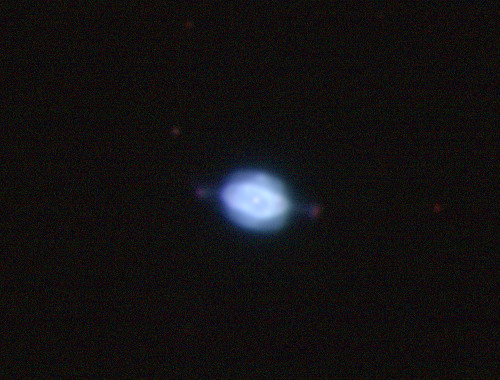
When looking at the image above it’s not hard to see how the Saturn nebula got its name, as it resembles the planet Saturn when the rings are turned almost edge on. The structures of this object are very complex, with the most interesting being the 2 ansae which are FLIER’s as described above. The central star which is clearly visible is currently still 20 times brighter than the sun, and vastly hotter at 55,000 C, but is steadily fading and developing into a white dwarf star.
References
The Evolution of the sun. http://www.astro.cornell.edu/academics/courses/astro201/evol_sun.htm
Nuclear Fusion in the sun. http://www.kcvs.ca/martin/astro/au/unit3/72/chp7_2.html
Gurzadyan, Grigor A. (1997), The Physics and Dynamics of Planetary Nebulae, Germany: Springer, p. 3, ISBN 3-540-60965-2
The Spirograph Nebula (IC 418), http://hubblesite.org/image/990/news_release/2000-28
Amazing photos! Thanks for posting :)
Downvoting a post can decrease pending rewards and make it less visible. Common reasons:
Submit
I really appreciate that @Miroki !
Downvoting a post can decrease pending rewards and make it less visible. Common reasons:
Submit
Your knowledge is impressive. Beautiful photos and writing, keep it up!
Downvoting a post can decrease pending rewards and make it less visible. Common reasons:
Submit
Thank you @Lior4 , I have more articles coming that you might enjoy.
Downvoting a post can decrease pending rewards and make it less visible. Common reasons:
Submit
Hey, glad to see its going so well! Keep it up :)
Downvoting a post can decrease pending rewards and make it less visible. Common reasons:
Submit
Will do, I've got a few more articles in the pipeline that you might enjoy :)
Downvoting a post can decrease pending rewards and make it less visible. Common reasons:
Submit
Great, I'll keep an eye out :)
Downvoting a post can decrease pending rewards and make it less visible. Common reasons:
Submit
This post has received a 1.04 % upvote from @drotto thanks to: @steemstem-bot.
Downvoting a post can decrease pending rewards and make it less visible. Common reasons:
Submit
Well done! This post has received a 16.67 % upvote from @litasio thanks to: @steemstem-bot. Whoop!
If you would like to delegate to the @LitasIO you can do so by clicking on the following links: 50SP, 100SP, 250SP, 500SP. Be sure to leave at least 50SP undelegated on your account.
Downvoting a post can decrease pending rewards and make it less visible. Common reasons:
Submit
Congratulations @terrylovejoy, this post is the fifth most rewarded post (based on pending payouts) in the last 12 hours written by a Dust account holder (accounts that hold between 0 and 0.01 Mega Vests). The total number of posts by Dust account holders during this period was 11759 and the total pending payments to posts in this category was $3685.34. To see the full list of highest paid posts across all accounts categories, click here.
If you do not wish to receive these messages in future, please reply stop to this comment.
Downvoting a post can decrease pending rewards and make it less visible. Common reasons:
Submit
Downvoting a post can decrease pending rewards and make it less visible. Common reasons:
Submit
@terrylovejoy
I didn't "get" the Spirograph nebula's image with diffraction grating. Is this a single exposure with multiple images of the same object? Or different exposures put together? Thanks!
Downvoting a post can decrease pending rewards and make it less visible. Common reasons:
Submit
@hrj . This was a single exposure. I hope the attached image helps clarify what you are looking at. A star shows a continuous rainbow spectrum because its light is fairly distributed over the entire visible spectrum whereas the planetary nebula shines in distinct points in the spectrum due to excitation of electrons in elements such as Hydrogen and Oxygen.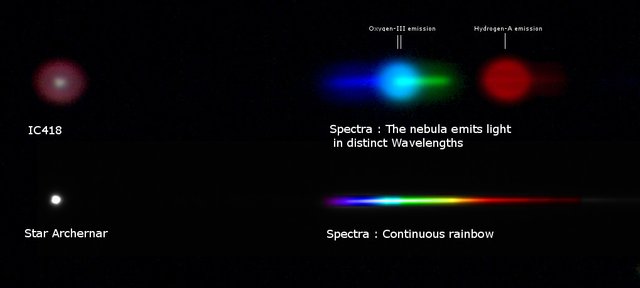
Downvoting a post can decrease pending rewards and make it less visible. Common reasons:
Submit
@terrylovejoy Ah yes.. I understand it better now. The circular shapes in the spectograph had confused me, but now I see that the shape is co-incidental, and not a super-imposed image of the nebula itself.
Thank you!
Downvoting a post can decrease pending rewards and make it less visible. Common reasons:
Submit